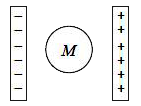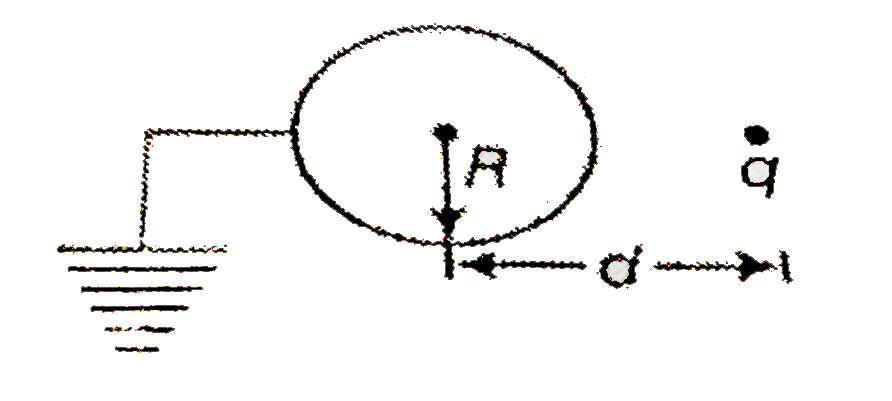Initially, sphere A has a charge of -50 e and sphere B has a charge of +20e. The sphere are made of conducting material and are identical in size. If the spheres then touch, when is the resulting charge on sphere A?
To solve the problem, we need to determine the resulting charge on sphere A after both spheres touch and then separate. Here’s a step-by-step breakdown of the solution:
Step 1: Identify Initial Charges
- Sphere A has a charge of -50e (where e is the charge of a single electron).
- Sphere B has a charge of +20e.
Step 2: Calculate Total Charge
- When the two spheres touch, the total charge is conserved. We can calculate the total charge before they touch:
Qtotal=QA+QB=(−50e)+(+20e)=−30e
Step 3: Distribute Charge Equally
- Since both spheres are identical and made of conducting material, the total charge will distribute equally between them when they are in contact.
- The total charge of -30e will be shared equally by the two spheres:
Q′A=Q′B=Qtotal2=−30e2=−15e
Step 4: Resulting Charge on Sphere A
- After the spheres are separated, the resulting charge on sphere A is:
Q′A=−15e
Final Answer
- The resulting charge on sphere A after the spheres touch and then separate is -15e.
---
- Sphere A has a charge of -50e (where e is the charge of a single electron).
- Sphere B has a charge of +20e.
- When the two spheres touch, the total charge is conserved. We can calculate the total charge before they touch:
Qtotal=QA+QB=(−50e)+(+20e)=−30e
- Since both spheres are identical and made of conducting material, the total charge will distribute equally between them when they are in contact.
- The total charge of -30e will be shared equally by the two spheres:
Q′A=Q′B=Qtotal2=−30e2=−15e
- After the spheres are separated, the resulting charge on sphere A is:
Q′A=−15e
- The resulting charge on sphere A after the spheres touch and then separate is -15e.
Topper's Solved these Questions
- ELECTRIC CHARGES AND FIELDSBook:RESNICK AND HALLIDAYChapter:ELECTRIC CHARGES AND FIELDSExercise:Problems
Explore 63 Videos
- ELECTRIC CHARGES AND FIELDSBook:RESNICK AND HALLIDAYChapter:ELECTRIC CHARGES AND FIELDSExercise:Practice Questions (Single Correct Choice Type)
Explore 45 Videos
- ELECTRIC CHARGES AND FIELDSBook:RESNICK AND HALLIDAYChapter:ELECTRIC CHARGES AND FIELDSExercise:Practice Questions (Integer Type )
Explore 3 Videos
- ELASTICITYBook:RESNICK AND HALLIDAYChapter:ELASTICITYExercise:PRACTICE QUESTIONS (Integer Type)
Explore 3 Videos
- ELECTRIC POTENTIALBook:RESNICK AND HALLIDAYChapter:ELECTRIC POTENTIALExercise:(PRACTICE QUESTIONS) Integer Type
Explore 1 Video
Similar Questions
Knowledge Check
A conducting sphere of radius r has a charge . Then .
Athe charge is uniformly distributed over its surface if there is an external electric field .BDistribution of charge over its surface will be non uniform if no external electric field exist in space,CElectric field strength inside the sphere will be equal to zero only when no external electric field existsDPotential at every point of the sphere must be sameConsider three identical metal spheres, A, B and C. Sphere A carries of −2.0μC, spheres B carries a charge of −6.0μC, and spheres C carries a charge of +5.0μC. Sphere A and B are touched together and then separated. Sphere B and C are then touched and separated. Does sphere C end up with an excess or a deficiency of electrons and how many electrons is it ?
Adeficiency, 6×1013Bexcess, 3×1013Cexcess, 2×1013Ddeficiency, 3×1012A hollow metallic sphere is charged. Insider the sphere
Athe potential is zero but the electric field is finiteBthe electric field is zero but the potential is finiteCbothe electric field and potential are finiteDboth the electric field and potential are zero
Two identical conducting spheres are charged by induction and then sepatatd by a large distance, sphere-1 has charge +Q and spher-2 has charge -Q. A third sphere is initially uncharged. If sphere-3 is touched to sphere-1 and sepatated and then touched to sphere-2 and separated what is the final charge on each of the three spheres?
View SolutionConsider two concentric conducting spheres. The outer sphere is hollow and initially has a charge −7Q on it. The inner sphere is solid and has a charge +2Q on it.
a. How much charge is on the outer surface and inner surface of the outer sphere.
b. If a wire is connected between the inner and outer sphere, after electrostatic equilibrium is established how much total charge is on the outer sphere? How much charge is on the outer surface and inner surface of the outer sphere? Does the electric field at the surface of the inside sphere change when the wire is connected?
c. We return to original condition in (a). We now connect the outer sphere to ground with a wire and then disconnect it. How much total charge will be on the outer sphere? How much charge will be on the inner surface and outer surface of the outer sphere?
View SolutionThe diagram shows a conducting sphere M between two oppositely charged metal plates.
What would be the resulting charge distribution on sphere M?

View SolutionA metal sphere has a charge of −6.5μC. When 5×1013 electrons are removed from the sphere, what would be the net charge on it?
View SolutionA hollow sphere of radius 2R is charged to V volts and another smaller sphere of radius R is charged to V/2 volts. Now the smaller sphere is placed inside the bigger sphere without changing the net charge on each sphere. The potential difference between the two spheres would be
View Solution
